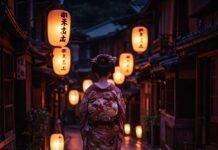Kyoto, Japan’s ancient capital, is a treasure trove of serene temples and breathtaking gardens that embody the essence of Zen and Japanese culture. Whether you’re a history buff, a nature lover, or a curious traveler, Kyoto’s temples and gardens offer an unforgettable journey into Japan’s soul. This guide uncovers the best spots to explore, practical tips for visiting, and insider insights to make your trip seamless and memorable.
Why Visit Kyoto’s Temples and Gardens?
Kyoto’s temples and gardens are more than just scenic spots—they’re windows into Japan’s spiritual and aesthetic heritage. With over 1,600 temples and 400 shrines, Kyoto is home to 17 UNESCO World Heritage Sites, many of which feature meticulously designed gardens that reflect Zen principles of harmony and simplicity. Visiting these sites offers a chance to disconnect from the modern world and reconnect with nature and history.

Top Kyoto Temples to Explore
Kyoto’s temples are architectural marvels, each with unique stories and serene atmospheres. Here are the best temples to include in your itinerary:
Kinkaku-ji: The Golden Pavilion
Kinkaku-ji, or the Golden Pavilion, is Kyoto’s most iconic temple, famous for its gold-leaf-covered upper floors shimmering against a tranquil pond. Built in 1397, it’s a UNESCO World Heritage Site and a symbol of opulence and Zen aesthetics.
- Why Visit: Stunning architecture and reflective gardens.
- Pro Tip: Visit early in the morning to avoid crowds.
- Cost: ¥400 (~$3 USD).
Outbound Link: Learn more about Kinkaku-ji’s history.
Fushimi Inari Taisha: The Thousand Torii Gates
While technically a shrine, Fushimi Inari Taisha is a must-visit for its vibrant red torii gates winding through Mount Inari. Dedicated to the Shinto god of rice, this site blends spirituality with natural beauty.
- Why Visit: Iconic photo opportunities and hiking trails.
- Pro Tip: Explore the upper trails for fewer crowds and panoramic views.
- Cost: Free.
Outbound Link: Fushimi Inari travel tips.

Best Kyoto Gardens for Serenity
Kyoto’s gardens are masterpieces of design, blending rocks, water, and plants to evoke peace. Here are the top gardens to visit:
Ryoan-ji: The Zen Rock Garden
Ryoan-ji’s karesansui (dry landscape) garden is world-famous for its minimalist rock arrangement, designed to inspire meditation. The 15 rocks, set in raked gravel, can’t all be seen from one angle—a metaphor for life’s mysteries.
- Why Visit: Perfect for quiet reflection.
- Pro Tip: Sit on the veranda and take time to absorb the garden’s calm.
- Cost: ¥500 (~$4 USD).
Outbound Link: Ryoan-ji garden insights.
Ginkaku-ji: The Silver Pavilion Garden
Ginkaku-ji, or the Silver Pavilion, boasts a serene garden with a sand mound shaped like Mount Fuji. Its moss-covered paths and pond create a tranquil escape.
- Why Visit: A blend of architecture and nature.
- Pro Tip: Visit in autumn for vibrant foliage.
- Cost: ¥500 (~$4 USD).

Practical Tips for Visiting Kyoto’s Temples and Gardens
To make the most of your Kyoto adventure, keep these tips in mind:
- Plan Your Route: Kyoto’s temples and gardens are spread out. Group sites by area (e.g., northern Kyoto for Kinkaku-ji and Ryoan-ji).
- Dress Respectfully: Wear comfortable shoes and modest clothing, especially at religious sites.
- Check Seasonal Events: Spring cherry blossoms and autumn foliage enhance the experience.
- Use Public Transport: Kyoto’s buses and trains are efficient. Get a Kyoto City Bus Pass for ¥600/day.
- Respect the Silence: Many sites are places of worship—keep noise to a minimum.
Outbound Link: Kyoto transportation guide.
Fun Facts About Kyoto’s Temples and Gardens
- Kyoto was Japan’s capital for over 1,000 years (794–1868).
- Ryoan-ji’s rock garden has inspired artists and philosophers worldwide.
- Fushimi Inari’s torii gates are donated by businesses and individuals, a tradition spanning centuries.
- Many gardens use “borrowed scenery,” incorporating distant mountains into their design.
Plan Your Kyoto Temples and Gardens Adventure
Kyoto’s temples and gardens are a journey into Japan’s heart, offering beauty, history, and tranquility. Start with Kinkaku-ji and Fushimi Inari for iconic experiences, then dive into the Zen calm of Ryoan-ji and Ginkaku-ji. With thoughtful planning and an open heart, your Kyoto trip will be unforgettable.
What’s your favorite Kyoto temple or garden? Share in the comments below, and let’s inspire each other’s travels!






































